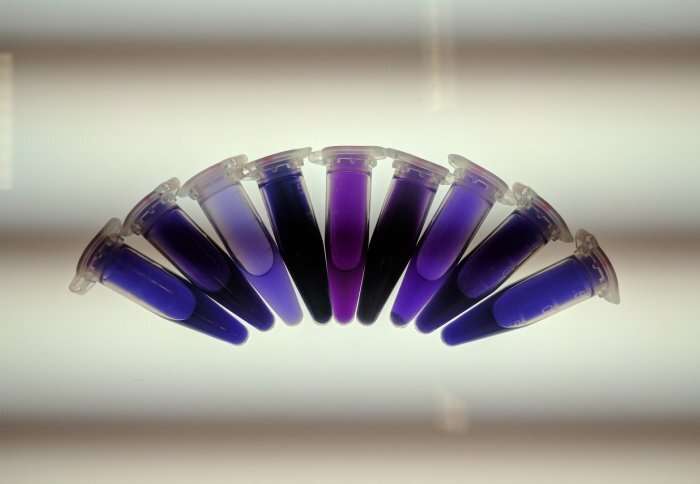Derivatives of violacein. Credit: Hung-En Lai
Researchers have engineered bacteria to produce new versions of a potential antibiotic molecule, some with potent antimalarial properties.
Using bacteria to produce new forms of potential drug molecules makes the process faster and cheaper, meaning new drugs could be discovered quicker. The new method, by Imperial College London researchers, is published in Antimicrobial Agents and Chemotherapy.
There were 228 million cases of malaria in 2018, and 405,000 deaths. The parasite that causes the disease is gaining resistance to frontline drug treatments, so new drugs and other interventions are needed to move towards malaria eradication.
One molecule, called violacein, is known to be able to kill the blood stage of the malaria-causing parasite Plasmodium falciparum. Violacein occurs naturally in some bacteria but is difficult to isolate and purify, making it costly and time-consuming to produce.
Now, researchers from Imperial engineered E. coli bacteria to produce violacein in an easily accessible format. They did this by introducing genes into E. coli that code for enzymes that make violacein.
Cutting out the chemistry
Bacteria have been engineered to produce molecules in this way before, but the team also went one step further. By changing what the E. coli ate, the team were also able to make the bacteria produce different versions of violacein.
They then tested the ability of these derivative versions to kill the malaria parasite in the lab, finding that one derivative was around 20 percent more potent than the original violacein.
Lead author Dr. Mark Wilkinson, from the Department of Life Sciences at Imperial, said: "We urgently need new drugs to fight malaria, but the process takes a long time when promising new molecules are hard to obtain with traditional chemistry.
"By combining synthetic biology with high-throughput screening, we are able to cut out some of the expensive chemistry, allowing us to not only make molecules more easily, but also to discover derivatives of those molecules that may be even more potent."
Next steps
Synthetic biologists are able to insert a greater number and type of enzymes into bacteria, paving the way for a new method of drug discovery.
The team are now working to identify how violacein and its derivatives kill the parasite. Knowing what the molecule targets will help researchers develop the drug further and to discover other molecules that work against the same target.
The researchers believe violacein works by changing the behavior of a protein involved in creating the parasite's cytoskeleton—the structure that helps cells maintain their shape.
More information: Mark D. Wilkinson et al. A Biosynthetic Platform for Antimalarial Drug Discovery, Antimicrobial Agents and Chemotherapy (2020). DOI: 10.1128/AAC.02129-19
Journal information: Antimicrobial Agents and Chemotherapy
Provided by Imperial College London























